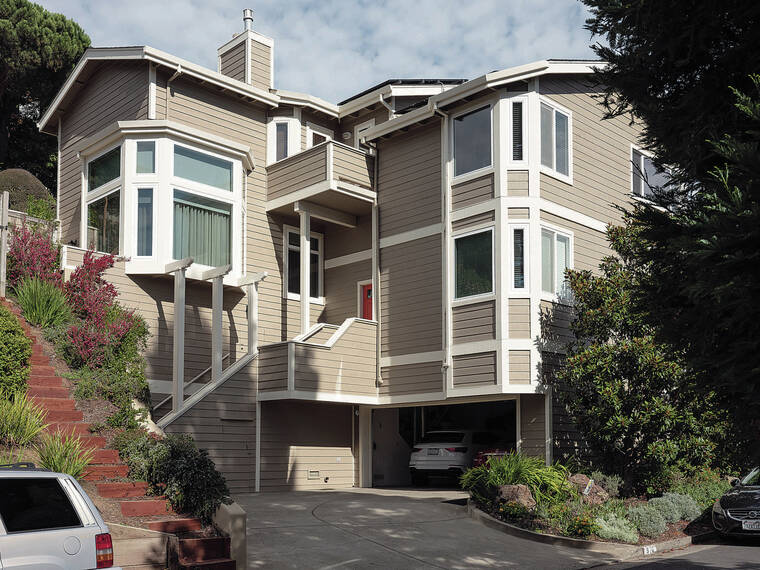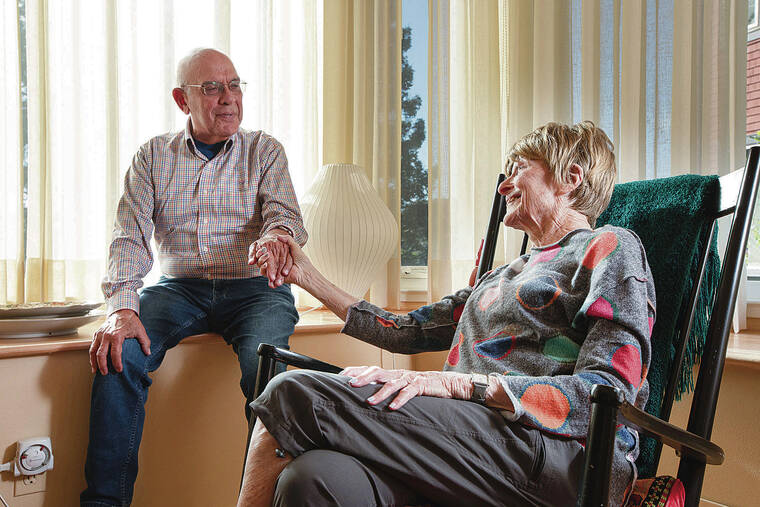Do we stay or do we go?

NEW YORK TIMES
Above, it’s 39 steps from the garage to the primary bedroom in their California home.

NEW YORK TIMES
Gerry Goldsholle, 83, and his wife, Myra Levenson, 84, have a home in Mill Valley, Calif., but spend half the year in a senior living community in Tucson, Ariz.


There are 39 steps from the spot Gerry Goldsholle and his wife, Myra Levenson, park the car at their four-level, wood-frame house in Mill Valley, Calif., to where, at the end of each evening, they park themselves.
“As you get older, those stairs get to be an issue, bringing up groceries and so forth,” said Goldsholle, 83, a lawyer.
Three years ago, Levenson, 84, a retired lawyer, began lobbying to return to Tucson, Ariz., where she had lived during her first marriage, and to move to a retirement community, then under construction.
But Goldsholle, who had never cared for his native New York and had eagerly moved to San Francisco three decades ago after the death of his first wife, wanted to stay in the Bay Area. “We’re both perfectly healthy and very active,” he said. “We go to theater. We drive at night.”
Yet, there was no denying those 39 steps. There was also “the recognition that as you get older, things happen or can happen,” Goldsholle said. Consequently, two years ago, they stripped the Mill Valley house of half its art and half its furniture, and relocated part time to Hacienda at the Canyon, a senior living community in Tucson.
“My wife would have been very happy to be in Arizona full time and I would much prefer to be in California full time — I was adamant that we were going to keep the house in Mill Valley as our base,” Goldsholle said. “But my wife has been a good sport and I’m willing to split the year with her.”
Don't miss out on what's happening!
Stay in touch with breaking news, as it happens, conveniently in your email inbox. It's FREE!
Among couples of a certain age, there are many iterations of the “What will we do in retirement?” question, said Gail Saltz, a psychiatrist in private practice in New York, and a clinical associate professor of psychiatry at the NewYork-Presbyterian Hospital, Weill-Cornell Medical College. “One iteration may be that one member of the couple wants to retire, the other doesn’t. One wants to travel; the other doesn’t.” And one thinks it would be a sage idea to move, sooner rather than later, to a continuing care retirement community or some equivalent, while the other is thinking some version of “Hell no, I won’t go.”
“There are a million different issues I’ve seen with couples at this stage of life because it’s a transition to something else,” Saltz added. “It may hark back to discussions around earlier transitions like, ‘Will we have children? How many? Will we stay in the city or raise them in the suburbs?’ ”
Of course, moving to a retirement community isn’t an option for everyone — even if spouses or partners are in agreement about the wisdom of such a decision. According to the National Investment Center for Seniors Housing & Care, a data service provider, the average entrance fee for a continuing care retirement community in the United States is $440,594, and the average monthly rent is $3,862.
The debate about longtime home versus senior living community is about a lot more than square footage and amenities. “Among older people, there is a reluctance to project negativity into their future,” said Merril Silverstein, a professor of sociology at Syracuse University. “There’s research that they tend to put on rose-colored glasses about things like their own aging trajectory so it’s keeping up their ego integrity to want to be independent and stay in their home.”
Saltz put it even more strongly. People might move to a senior living facility “when they’re totally able-bodied,” she said. “But implicit in that is that they’re old. And in our culture, being old means less relevant, less important, put out to pasture. And if that’s how you think, the idea of moving to a retirement community is not going to be welcome.”
Ann Hammond is coming to grips with just such issues. Some while back, when the doctor started mentioning things such as grab bars in the shower to her and her husband, John, “I was saying, ‘I’m still young,’ ” recalled Hammond, 74, a retired psychologist in Virginia Beach, Va. “But my husband is seven years older than I am. When you’re in your 80s, you have to start considering things like that.”
The age difference has led the couple to consider not just a change of bathroom fixtures but a change of address — from their town house to a continuing care retirement community. John Hammond, a former journalist and retired training program administrator for the U.S. naval shipyard system, is more psychologically prepared for the move than his wife.
“When you go visit a retirement community and you’re seeing a lot of infirm people, the problems that come with aging get to be a bit discouraging,” Ann Hammond said. “It feels like I’m not ready to face that yet.
“I’m trying to find a place that will make it more palatable for me, somewhere that has a connection to a university,” she said. “I want to be with healthier people in a vibrant community, and that can be difficult to find.”
Grayson Miller, a retired doctor, and his wife, Nancy, signed a waiting list at a continuing care community in Richmond, Va., six or seven years ago, but as time went on, “Nancy started to change her mind,” said Grayson Miller, now 81.
The issue was the couple’s home, a Dutch colonial that they had owned for 45 years. “She’d done everything to it. It was her house, and she thought it was pretty much perfect,” said Grayson Miller, who loved the property too.
But the spina bifida he had suffered his whole life was getting worse; walking was becoming more problematic, “and I knew that somewhere along the line, I was going to need more support than I could get at home, so I kept trying to persuade her,” he said. “There’s no doubt that I was looking at the future. My wife and I were roughly the same age, and I knew it was just a matter of time before one or the other of us was going to need assistance.”
In early 2022, Nancy began showing symptoms of Lou Gehrig’s disease and died eight months later. Six months ago, Miller moved into a one-bedroom apartment at Cedarfield, a continuing care community in Richmond. “If my wife were still alive, I think I could have convinced her to come here,” he said. “She was a smart woman. And I think she would have liked it.”
© 2023 The New York Times Company



